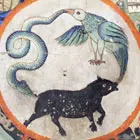
Second Truth – The Cause of Dissatisfaction (Samudāya)
The Buddha taught that the root of all suffering is desire, tanhā (in Pali) or craving. Described as one of the Three Roots of Evil, greed or desire is represented by a rooster. The other two Roots are ignorance or delusion, represented by a pig, and hatred or destructive urges, represented by a snake. The Roots are depicted in a circle, each reinforcing the other.
The causes of our daily troubles, like thirst, pain and sadness, seem easily identifiable. In the Second Truth, the Buddha found the cause of suffering is more deeply rooted than our immediate worries.
Facing any inconvenience or annoyance, the tendency for us is to immediately eliminate it. We seek pleasure in what is new or exciting. We emphasise youth’s beauties and pleasures whilst the challenging side of life — old age, sickness, death, despair and depression are denied. When bored, we pursue something interesting. When frightened, we seek safety. This is perfectly natural, the mind pursues what it likes and tries to suppress what it doesn’t. Our attachment to positive, negative and neutral sensations leads to suffering.
These teachings are radically different than our evolutionary conditioning. We live in societies where everything is polished and pleasing, not always showing how things actually are, conditioning us to avoid what is unpleasant.
In India, my birthplace, we see life out in the open, from sickness and suffering to old age and death. Grandparents lived with the family so you witness the process of aging and the inevitable decline. I watched my grandmother slowly going blind, eventually being confined to her room. During visits home, I would take meals to her room. She would call me to her so she could touch me. I sensed that was how she recognised me and not by my name, even though I was named after her. Death isn’t hidden. We participate in neighborhood funerals, as wakes were held at home with the body. These are not fun events – but it was reality.
“A tree lives on its roots. If you change the root, you change the tree. Culture lives in human beings. If you change the human heart, the culture will follow.”
– Jane Hirshfield, American poet
To actually “suffer better”, look at it and be with it, in a way to suffer but without the reactivity.
Aside from these realities of life, there are other forms of suffering. There are things that we want, yet we cannot have them. The happiness that we get from things in life never lasts – they die, leave or change.
The goal for all beings is to not suffer. The Buddha’s journey was to understand how to do that. We need to cultivate a steady and calm presence and then watch the suffering to help us deeply understand it. In being present for suffering we are not amplifying it with denial, anger or despair. This is a difficult task. Learning to sit with it is a gradual process of building capacity by being grounded and centered to find that ledge. We begin by breathing – so from a more peaceful place we can observe our suffering closely.
The teaching is that we won’t find lasting happiness and peace in a thing or experience due to the impermanent nature of all things. Any attempt to hold on to something “as it is”, thinking “this will make me happy” doesn’t last. I thought becoming a teacher with IMCW would bring me ultimate happiness. Within weeks of the news, I am not any more or less happy than before. Freedom and happiness come from not clinging or resisting. The purpose of really getting to know the pain, understand it clearly, is the absence of clinging.
We are not eliminating the object of our suffering, but the cause. We cannot control what happens, but we can control how we think and respond.
To eliminate something, we have to understand the cause, this encapsulates the Second Truth.
“Every human being wants happiness. The Buddha acts like a teacher to show the path, that is all. You are your own master. Everything depends on your shoulder.”
– His Holiness, The Dalai Lama
